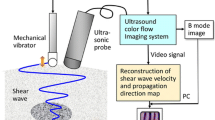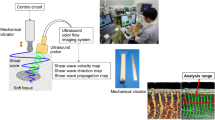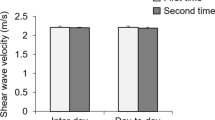Abstract
Purpose
Continuous shear wave elastography (C-SWE) can be expected to be applied to portable muscle elasticity diagnosis. To establish diagnostic technology, it will be necessary to improve measurement techniques and quantitative measurement accuracy.
Methods
In this study, we investigated two screen scores: the quality index (Q-index), which determines whether the intensity of a power Doppler image is appropriate, and the shear wave propagation direction index (SWDI), which determines the uniformity of shear wave propagation.
Results
First, we performed numerical simulations with white noise and found that the coefficient of variation of shear wave velocity estimation was less than 5% when the normalized Q-index was greater than 0.27. Furthermore, regarding the SWDI, we clarified the relationship between the standard deviation in shear wave propagation direction and the SWDI. Next, the relationship between the Q-index and coefficient of variation of estimated shear wave velocity was evaluated through experiments using a tissue-mimicking phantom. The results showed that there was a negative correlation between the Q-index and the coefficient of variation, and the fluctuation of the propagation velocity could be inferred from the Q-index. Finally, we showed the results of applying the screen scores to muscle relaxation monitoring and confirmed its usefulness in clinical applications.
Conclusion
By applying the screen scores, we showed improved stability in speed estimation in C-SWE, and demonstrated the possibility of clinical applicability.








Similar content being viewed by others
References
Bamber JC. Ultrasound elasticity imaging: definition and technology. Eur Radiol. 1999;9:327–30.
Shiina T, Nitta N, Ueno E, et al. Real time tissue elasticity imaging using the combined autocorrelation method. J Med Ultrason. 1999;26:57–66.
Sarvazyan AP, Rudenko OV, Swanson SD, et al. Shear wave elasticity imaging—a new ultrasonic technology of medical diagnostic. Ultrasound Med Biol. 1998;20:1419–36.
Fatemi M, Manduca A, Greenleaf JF. Imaging elastic properties of biological tissues by low-frequency harmonic vibration. Proc IEEE. 2003;91:1503–19.
Nightingale KR, Palmeri ML, Nightingale RW, et al. On the feasibility of remote palpation using acoustic radiation force. J Acoust Soc Am. 2001;110:625–34.
Bercoff J, Tanter M, Fink M. Supersonic shear imaging: a new technique for soft tissue elasticity mapping. IEEE Trans Ultrason Ferroelectr Freq Control. 2004;51:396–409.
Takashima M, Arai Y, Kawamura A, et al. Quantitative evaluation of masseter muscle stiffness in patients with temporomandibular disorders using shear wave elastography. J Prosthodont Res. 2017;61:432–8.
Ewertsen C, Carlsen J, Perveez AM, et al. Reference values for shear wave elastography of neck and shoulder muscles in healthy individuals. Ultrasound Int Open. 2018;4:E23–9.
Šarabon N, Kozinc Ž, Podrekar N. Using shear-wave elastography in skeletal muscle: a repeatability and reproducibility study on biceps femoris muscle. PLoS ONE. 2019;14: e0222008.
Tabaru M, Yoshikawa H, Azuma T, et al. Experimental study on temperature rise of acoustic radiation force elastography. J Med Ultrasonics. 2012;39:137–46.
Issaoui M, Debost-Legrand A, Skerl K, et al. Shear wave elastography safety in fetus: a quantitative health risk assessment. Diagn Interv Imaging. 2018;99:519–24.
Sugitani M, Fujita Y, Yumoto Y, et al. A new method for measurement of placental elasticity: acoustic radiation force impulse imaging. Placenta. 2013;34:1009–13.
Partin A, Hah Z, Barry CT, et al. Elasticity estimates from images of crawling waves generated by miniature surface sources. Ultrasound Med Biol. 2014;40:685–94.
Sandrin L, Fourquet B, Hasquenoph J, et al. Transient elastography: a new noninvasive method for assessment of hepatic fibrosis. Ultrasound in Med & Biol. 2003;29:1705–13.
Yamakoshi Y, Nakajima T, Kasahara T, et al. Shear wave imaging of breast tissue by color Doppler shear wave elastography. IEEE Trans Ultrason Ferroelectr Freq Control. 2017;64:340–8.
Tsuchida W, Yamakoshi Y, Matsuo S, et al. Application of the novel estimation method by shear wave elastography using vibrator to human skeletal muscle. Sci Rep. 2020;10:22248.
Yamamoto A, Yamakoshi Y, Ohsawa T, et al. Shear wave velocity measurement of upper trapezius muscle by color Doppler shear wave imaging. J Med Ultrasonic. 2018;45:129–36.
Kodesho T, Taniguchi K, Kato T, et al. Relationship between shear elastic modulus and passive force of the human rectus femoris at multiple sites: a thiel soft-embalmed cadaver study. J Med Ultrasonic. 2021;48:115–21.
Zhao H, Song P, Meixner DD, et al. External vibration multi-directional ultrasound shearwave elastography (EVMUSE): application in liver fibrosis staging. IEEE Trans Med Imaging. 2014;33:2140–8.
Deffieux T, Gennisson JL, Bercoff J, et al. On the effects of reflected waves in transient shear wave elastography. IEEE Trans Ultrason Ferroelectr Freq Control. 2011;58:2032–5.
Izquierdo MAG, Hernandez MG, Graullera O, et al. Time–frequency wiener filtering for structural noise reduction. Ultrasonics. 2002;40:259–61.
Tano N, Koda R, Tanigawa S, et al. Development of shear wave propagation simulation model for liver viscoelasticity measurement. In: Proc USE2023. 2023; p. 2P5–16.
Aoyagi M. Fabrication of an ultrasound phantom using gelling agent of resistant to putrefaction (Researches and Overseas Activities). Repo Res Nippon Inst Technol. 2017;46:27–30.
Catheline A, Wu F, Fink M. A solution to diffraction biases in sonoelasticity: the acoustic impulse technique. J Acoust Soc Am. 1999;105:2941–50.
Michailovich OV, Tannenbaum A. Despeckling of medical ultrasound images. IEEE Trans Ultrason Ferroelectr Freq Control. 2006;53:64–78.
Acknowledgements
Part of this work was supported by JSPS KAKENHI Grant Number 22K04134 and the Cooperative Research Project of Research Center for Biomedical Engineering.
Author information
Authors and Affiliations
Corresponding author
Ethics declarations
Conflict of interest
The authors declare that there are no conflicts of interest.
Ethical approval
The experiment involving application of scores to muscle relaxation monitoring was approved by the Ethics Committee of Gunma University Hospital as “research on measuring muscle elasticity of skeletal muscles using continuous shear wave elastography.” It was conducted with written and verbal consent.
Additional information
Publisher's Note
Springer Nature remains neutral with regard to jurisdictional claims in published maps and institutional affiliations.
Supplementary Information
Below is the link to the electronic supplementary material.
10396_2024_1439_MOESM1_ESM.pptx
Movie 1: Examples of shear wave records of biceps brachii. PD image records considered to be of (a) high and (b) low quality. Movie 2: Examples of shear wave propagation direction records of vastus lateralis muscle with (a) high and (b) low SWDI values. Movie 3: Results of shear wave records of vastus lateralis muscle in clinical study. PD image records of Frame #5, #25, and #51 are high-quality images. PD image records of Frame #46 have low SWDI. PD image records of Frame #43 of CV is larger than 20%. Images of Frame #43 and #46 are excluded. Movie 4: Results of shear wave records of vastus lateralis muscle in clinical study. Shear wave propagation direction records for high-quality images (Frame #5, #25, and #51) and excluded images (Frame #43 and #46)
About this article
Cite this article
Tabaru, M., Koda, R., Shitara, H. et al. Examination of rapid adjustment system based on screen score obtained using continuous shear wave elastography. J Med Ultrasonics (2024). https://doi.org/10.1007/s10396-024-01439-7
Received:
Accepted:
Published:
DOI: https://doi.org/10.1007/s10396-024-01439-7




